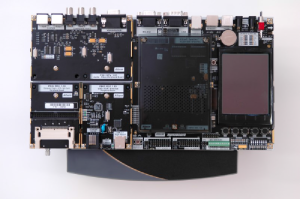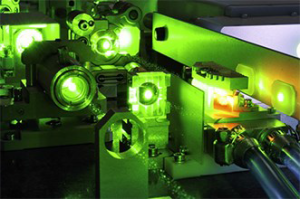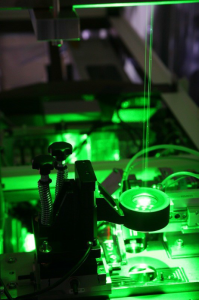The main purpose of the laser lithography is to expose patterns in photoresist that has been spun on a substrate such as glass or a semiconducting wafer. The instrument is “maskless” in that no prefabricated masks are necessary; instead, the resist is exposed by scanning a submicron UV laser spot over the substrate surface while turning the laser on and off to expose the desired pattern.
The laser lithography laser writer is a direct-write (maskless) lithography system produced by Microtech s.r.l. of Italy. The tool contains two laser diode assemblies for the efficient exposure of both positive and negative photoresists. The five objective lenses allow for a broad range of high resolution and high-speed writing applications. In addition to traditional binary patterns, the system supports grayscale patterning with 256 level control. A 10 nm interferometric nanopositioning stage allows for 0.8 µm patterning over the full 100 x 100 mm working area of the stage.
Pattern generation using Electron or Laser Beam Lithography techniques is a complex process that heavily depends, other than equipment, on the properties of the lithographic materials used. These materials, undergoing developing processes downstream to selectively remove or removed directly on Maskless Lithography applications, dictate a strict set of rules for Electron or Laser Beam driving profile.
C2P is a state of the art Signal Processor that, additionally to developing write strategies for E/L-Beam driving, controls a laser beam deflector that acts vertically to your beam scanning path to allow high-speed pattern generation in your focused beam neighboring area. When combined with our r-theta exposure stages, C2P can pattern XY geometries with higher accuracy and at higher speeds than actual XY systems.
AVAILABLE SYSTEM OPTIONS:
Beam/Pulse Write Strategy Tools
High Accuracy Timing Units
Linear and Rotary Stage Controls
Laser Diode Modulators
Cartesian to Polar Converters

A broad range of gas and diode laser sources is available for system integration and standalone use. Ranging from perfect Gaussian gas lasers to cutting edge ultra-fast systems and power diodes, our experience in laser technologies and partnerships with the world’s leading manufacturers can warranty laser sources that perfectly fits any laboratory or industrial application.
Our systems integrate application specific electronic controls and custom made optics that enable drop in replacements for existing systems or advanced engineering options on new designs. Been perfect match for our Optical Assembly offering and covering all commercially available wavelengths, we offer one-stop laser processing tools for power and precision focused applications like Precision Laser Welding and Nano-Imprint Lithography.
AVAILABLE SYSTEM OPTIONS:
CW and Ultrafast Systems
Various Pulse Modulated Sources
Low-Noise Diode Laser P/S
Beam Shaping Optics Integration
Standalone System Control HMI

High speed Autofocusing and Optical Pick-Up Head sub-assemblies are the most critical components in any dynamic, thin film laser processing application. Processing Silicon and Quartz wafers typically involves high speed scanning across the surface of the substrate while maintaining extremely tightly focused laser beam spots.
With typical scanning speeds exceeding 3m/s (demanding industrial users look into the 10m/s realm) and focus depths for micro/nano scale pattern generation falling well under the micro-meter range, autofocusing mechanics and control electronics undergo immense pressure. With more than 15 years of experience in designing and innovating Optical Pick-Up Head Assemblies for the optical storage industry, the performance of our product portfolio will meet and exceed your most challenging demands.
AVAILABLE SYSTEM OPTIONS:
VCMotor and Piezoelectric Stages
Dual Beam Focusing Systems
Optical and Mechanical Autofocus
Broad Range of Focusing Objectives
BTO Electronic Interfacing
